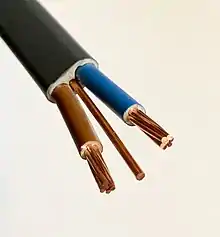Twin and earth
Twin and earth (often written "T&E" and sometimes "T and E") cable is a colloquial name in the UK, Australia, New Zealand and other countries for a type of flat sheathed fixed mains electricity cable, containing two insulated current-carrying conductors and an Earth connector. In Australia and New Zealand this type of cable is referred to as 'Flat TPS' (Thermo-plastic sheathed), as well as "Twin and Earth" or "Twin with Earth".

Construction
These cables comprise two individually insulated current carrying conductors and a Circuit Protective Conductor (CPC = PE = Earth). , but it is not intended to be used where it is subject to regular movement or sunlight, because the sheathing is affected by ultraviolet radiation.
Uses
It is commonly used for fixed wiring in domestic and commercial premises.
Limitations
Twin and Earth cable is not designed to withstand significant mechanical abuse. It should not be installed in areas where it could be subject to abrasion or blows without additional mechanical protection. It must be installed so that it is physically supported at regular intervals. It is not suitable for overhead catenary use.
Twin and Earth cable is normally made with PVC sheathing and insulation, which has an almost indefinite life in the right conditions. However UV light will cause it to fail, so Twin and Earth is not suitable for use outdoors.
It has a temperature rating of 70 °C, including the temperature rise from resistive heating in the cable.
PVC gives off hazardous smoke when burned. National standards for electrical wiring prohibit PVC cables in locations where this is a particular risk, such as fire escape routes.
A particularly insidious risk with PVC cable occurs when it comes into contact with expanded polystyrene insulation, either in rigid panels or as loose beads. [1]
Some Twin and Earth cable manufactured in the late 1960s and early 1970s had a deficiency in its manufacture which over time results in the production of a green conductive slime.[2]
Regional variations
United Kingdom
In the UK the CPC is uninsulated (bare) and of reduced diameter compared to the main cores. Green and yellow sleeving, which is sold separately, is required to be used to cover the exposed ends. There is an overall sheath of grey PVC (BS 6004), or white for low smoke compound (BS 7211), although prior to 2005 white sheathing was also available in PVC.
Core and sheathing colours may be throughout the thickness of the material, or only on the surface. The latter means that any damage such as accidental knife cuts are readily visible.
Republic of Ireland
In the Republic of Ireland the situation is different. From 2013, Irish wiring rules require a CPC with a cross-section equal to that of the main conductors and insulated in green and yellow inside the full length of the cable, from the new standard IS 201-4:2013.[3] [4] The older bare and reduced diameter CPC cables are no longer permitted for new wiring in the Republic of Ireland.
UK wiring regulations however do not at present (BS 7671:2018) recognise Twin and Earth or Flat TPS with a full sized and insulated (G/Y) earth conductor as a permitted cable type, which may be awkward for contractors who work cross-border.
Versions of flat cable are also available in smaller conductor sizes containing three current-carrying conductors in addition to the circuit protective (earth) conductor. These configurations are commonly used for applications such as switched light circuits, battery-backed emergency lighting which requires a switched and unswitched supply, extractor fans with a run-on timer which require a switched and unswitched supply, mains-powered interlinked smoke alarms, and central heating thermostats.
Australia and New Zealand
In Australia and New Zealand flat 'TPS' (Thermo-plastic sheathed) "Twin and Earth" cable manufactured prior to 1966 permitted the use of an uninsulated CPC stranded core, requiring the exposed ends of this conductor to be sleeved with Green insulating tubing. . (Before the advent of PVC, this tubing was varnished cambric.) Since 1966 it has been required that the CPC be insulated with Green insulation and since 1980 the colour of this insulation has been Green/Yellow.[5]
In Australia and New Zealand Single conductor and Twin conductor TPS cables also exist. These are required because it is not permitted in Australia and New Zealand for the Neutral conductor in a "Twin and Earth" cable to be "re-purposed" as a "Switched Line" conductor, as is permitted the UK and in North America.
"Three Conductor plus Earth" TPS cables also exist, having uses in multiway switching.
The conductor in a "Single TPS" cable usually has Red insulation and the conductors in a "Twin TPS" cable usually have Red and White insulation - with the White usually used as a "Switched Line" conductor.
1 mm² TPS cables have solid current carrying conductors.
1.5 mm² to 2.5 mm² TPS cables are available with both solid and stranded current carrying conductors but the solid conductors are not usually used since they are more difficult to work with.
TPS cables greater than 2.5 mm² have stranded conductors.
The CPC conductor is always stranded.
Standard UK metric twin and earth cable sizes
1/1 mm² and 1.5/1 mm² have solid conductors and CPC
2.5/1.5mm² has a solid CPC and may have solid or stranded conductors
4/1.5 mm² and 6/2.5 mm² have stranded conductors and a solid CPC
10/4 mm² and 16/6 mm² have stranded conductors and CPC
References
- Prolonged contact will cause the PVC to harden and crack, which can cause electrical fires."PVC cable insulation and polystyrene insulation - East Sussex Fire & Rescue Service".
- Ward, John. "Green Slime in Older PVC Insulated Cables". Retrieved 16 May 2020.
- "BASEC News". BASEC. Retrieved 2015. Check date values in:
|accessdate=(help) - http://www.meteorelectrical.com/images/6193Y_1.5mm_Twin__Insulated_Earth_Bluebrown_Cable_100M_m.jpg
- Electrical wiring